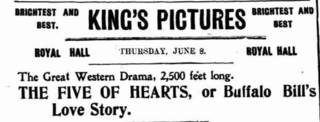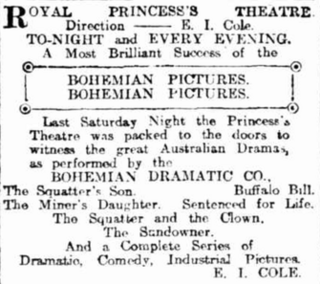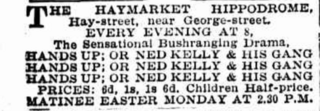
Bushrangers were originally escaped convicts in the early years of the British settlement of Australia who used the bush as a refuge to hide from the authorities. By the 1820s, the term had evolved to refer to those who took up "robbery under arms" as a way of life, using the bush as their base.

Eureka Stockade is a 1949 British film of the story surrounding Irish-Australian rebel and politician Peter Lalor and the gold miners' rebellion of 1854 at the Eureka Stockade in Ballarat, Victoria, in the Australian Western genre.

Hugh Chilman Buckler was a British actor. He was married to stage actress Violet Paget, about whom little has been found, save that she was somehow related to the Marquess of Anglesey. The film actor John Buckler was their son.
The Squatter's Daughter or, The Land of the Wattle is a 1907 Australian play by Bert Bailey and Edmund Duggan, writing under the combined pseudonym Albert Edmunds.
The Squatter's Daughter is a 1910 Australian silent film based on the popular play by Bert Bailey and Edmund Duggan.

Bushranger's Ransom, or A Ride for Life was an Australian silent film produced by Pathé Frères' in 1911, their first motion picture production in Australia after establishing a branch office in Sydney in April 1910. It was adapted from a stage play first performed in 1907 by E. I. Cole's Bohemian Dramatic Company.

The Five of Hearts, or Buffalo Bill's Love Story is a 1911 Australian film from Edward Irham Cole based on a stage play about Buffalo Bill which Cole had performed extensively. It is also known as A Maiden's Distress or Buffalo Bill. It was reportedly the longest of Cole's films.

Sentenced for Life is an Australian film directed by E. I. Cole. It was an adaptation of a play performed by Cole and his Bohemian Dramatic Company as early as 1904.

The Sundowner is an Australian film shot in Victoria. Set in the Australian bush, it was billed as "a romance with many startling adventures".
Gambler's Gold is a 1911 Australian film based on the 1911 novel by Arthur Wright. It is considered a lost film.

Edward Irham Cole was an Australian theatrical entrepreneur and film director whose productions represented a synthesis of Wild West show and stage melodrama. He managed a theatre company, called the Bohemian Dramatic Company, that performed in semi-permanent and temporary tent theatres. During 1910 and 1911 Cole directed a number of silent films, adapted from his stage plays and using actors from his theatre company.

The Squatter and the Clown is a 1911 Australian silent film. It was one of a series of films made by Edward Irham Cole's Bohemian Dramatic Company.
Thomas Smith Bellair was an English actor who moved to Australia, where he had his own dramatic company before managing various hotels, finally settling in Wagga Wagga, where his family became prominent citizens.
Jack Beresford Fowler, generally referred to as Beresford Fowler or J. Beresford Fowler, was an Australian actor and stage director, remembered for his little theatre productions in Melbourne.
The King of the Road is a 1900 Australian play performed by Edward Irham Cole performed by Cole's Bohemian Drama Company about the bushranger Ben Hall.

Hands Up, or Ned Kelly and His Gang is a 1900 Australian play by Edward Irham Cole about Ned Kelly.
Whirlwind, the Bushranger, or the Roaring Forties is a 1907 Australian play by Edward Irham Cole about the ficitious bushranger.
Coo-ee; Or, Wild Days in the Bush is a 1906 Australian play by Edward William O'Sullivan. It was originally performed by Edward Irham Cole's Bohemian Dramatic Company.
Captain Moonlite, the Wantabadgery Bushranger is a 1906 Australian play about the bushranger Captain Moonlite that was first produced by Edward Irham Cole's Bohemian Dramatic Company.
For King and Empire is a 1906 Australian play by Edward Irham Cole although several scenes and incidents were suggested by Edward William O'Sullivan.










